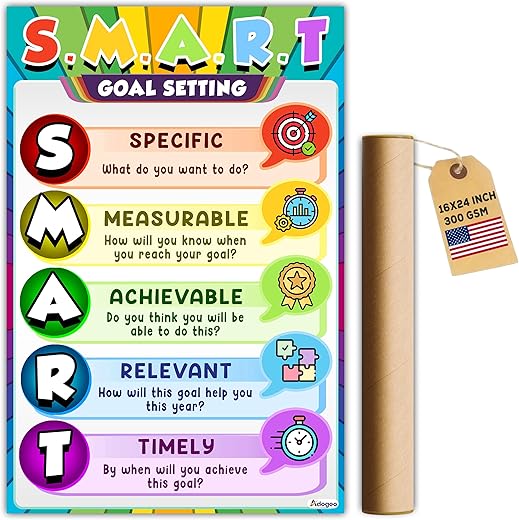Understanding SMART Goals
When it comes to achieving any objective, whether personal or professional, setting clear goals can significantly increase your chances of success. One popular framework for creating effective goals is the SMART criteria. SMART stands for Specific, Measurable, Achievable, Relevant, and Time-bound. By ensuring your goals fit into these five categories, you transform vague intentions into actionable plans that lead to measurable results.
What are SMART Goals?
- Specific: Goals need to be clear and specific. This means you should know exactly what you want to achieve. A specific goal will usually answer the questions: What do I want to accomplish? Why is this goal important? Who is involved? Where will it be done?Example: Instead of saying, “I want to get fit,” a specific goal would be, “I want to lose 10 pounds by exercising and eating a healthier diet.”
- Measurable: A goal should have criteria for measuring progress. This means you need to quantify your objectives to track your progress effectively. This can include metrics such as time, weight, numbers, or other quantifiable parameters.Example: Instead of stating, “I want to save money,” you could say, “I want to save $5,000 for a vacation by the end of the year.”
- Achievable: Goals should be realistic and attainable, yet challenging. While it’s important to stretch your capabilities, setting unattainable goals can lead to frustration and demoralization. Evaluate the constraints and establish if your goal is feasible.Example: Instead of aiming to “run a marathon within a month,” a more achievable goal would be, “I want to run a 5K in 3 months, increasing my training pace from 12 minutes per mile to 10 minutes per mile.”
- Relevant: Your goals should align with your broader objectives and life values. This step ensures that the goals you set are meaningful to you and make sense in the context of where you want to go in life.Example: If your long-term goal is to become a graphic designer, instead of learning underwater welding, you might set a goal to “complete a certification course in Adobe Illustrator in six months.”
- Time-bound: Goals need a deadline. Setting a timeframe creates a sense of urgency and prompts you to take action. This also helps you remain focused and accountable.Example: Rather than saying, “I want to improve my public speaking,” transform it into, “I will attend a local Toastmasters club meeting twice a month for the next six months.”
The Importance of Setting Clear and Attainable Goals
Setting SMART goals reduces ambiguity and enhances clarity in your intentions. Ambiguous goals lead to confusion, lack of direction, and decreased motivation. When your objectives are defined clearly, you are more likely to take consistent actions toward achieving them, ultimately increasing the likelihood of success.
Benefits of SMART Goals
Transforming Vague Intentions into SMART Goals
Here are practical examples of how to turn ambiguous objectives into SMART goals:
| Vague Intention | SMART Goal |
|---|---|
| I want to read more books. | I will read one book related to personal development every month for the next six months. |
| I want to learn a new language. | I will complete a Spanish language course via the Duolingo app, reaching level A2 in six months. |
| I want to be more social. | I will attend one networking event each month for the next four months and meet at least 2 new people. |
| I want to eat healthier. | I will plan and prepare five vegetarian meals each week for the next two months. |
Example in Real Life
Consider a company like Nike, which has a mission to empower athletes worldwide. A SMART goal for a team member interested in improving fitness might be framed as follows:
By structuring goals in this manner, both individuals and organizations can focus their efforts effectively, making progress more achievable.
Emphasizing the importance of SMART goals, it is evident that adopting this structure leads to winning strategies, whether for personal development, career advancement, or organizational growth.
Assessing Your Values and Priorities
Aligning your personal goals with your values and priorities is crucial for achieving a fulfilling and enriched life. When your aspirations resonate with what’s most important to you, they become more motivating and sustainable. This section will explore the significance of this alignment and provide practical methods to help you assess and clarify your core values.
The Importance of Aligning Goals with Personal Values
Your values are essentially the beliefs and principles that guide your behavior and decisions. When you align your goals with these values, you enhance your sense of purpose and satisfaction. Here are some key benefits of this alignment:
Reflecting on What’s Most Important
To understand your values better and identify what holds the greatest significance in your life, spend time reflecting on various aspects:
Methods to Assess Your Values
Here are two effective methods you can use to assess your values and priorities:
1. Journaling
Journaling is a powerful introspective tool. Consider these prompts:
2. Prioritization Matrix
Creating a prioritization matrix can help clarify which goals deserve your focus. Here’s a simple structure to get you started:
| Urgent | Not Urgent | |
|---|---|---|
| Important | – Finalizing a work project | – Starting a personal blog |
| Not Important | – Replying to emails | – Watching a sitcom |
Practical Examples for Reflection
Here are some examples you can consider when assessing your values:
By thoroughly reflecting on and assessing your personal values and priorities, you empower yourself to set meaningful goals that are in harmony with your genuine self. Start today by choosing one method that resonates with you, and observe how your understanding of your values evolves over time.
Breaking Down Goals into Actionable Steps
Setting ambitious goals can be exhilarating, but the gap between aspiration and achievement can often feel daunting. To bridge this gap, breaking larger goals into smaller, manageable tasks is crucial. This not only makes the process less overwhelming but also creates a pathway for tangible progress. Here’s how to effectively break down your goals, create a roadmap, and maintain momentum throughout the year.
The Process of Breaking Down Larger Goals
1. Define Your Main Goal
Start by clearly defining your main goal. For example, if your objective is to run a marathon, be specific. Your goal could be “to complete the New York City Marathon by November 2024.” Ensure your goal follows the SMART criteria—Specific, Measurable, Achievable, Relevant, and Time-bound.
2. Identify Key Milestones
Once your main goal is in place, identify key milestones that will lead you to success. In the marathon example, milestones may include:
3. Break Down Milestones into Actionable Steps
Transform each milestone into smaller, actionable tasks. For instance, to prepare for your 5K run, your tasks could include:
4. Create a Roadmap
A visual roadmap can be an effective tool in preventing overwhelm. Use tools like Trello or Asana to create a board that outlines your main goal, milestones, and tasks. Alternatively, you can create a simple table to visualize your steps:
| Date | Milestone | Tasks to Complete | Status |
|---|---|---|---|
| Jan 2024 | 5K Training Begins | Follow training plan; buy shoes | In Progress |
| Mar 2024 | Complete 5K | Register for local 5K; participate | Not Started |
| Jun 2024 | Half-Marathon | Increase mileage; practice endurance runs | Not Started |
| Nov 2024 | Complete Marathon | Taper before the race; study the course map | Not Started |
Preventing Overwhelm and Fostering Progress
Breaking tasks into smaller steps can significantly reduce feelings of overwhelm. Large goals may seem insurmountable, but when you turn them into bite-sized tasks, you gain a sense of control. Completing these smaller tasks fosters a sense of progress, which can be immensely motivating.
Celebrate Small Wins
Recognize and celebrate your achievements, no matter how small. Completing your first training run or reaching every milestone is worthy of acknowledgment. This could be as simple as sharing your progress with friends on social media or treating yourself to a healthy meal from a restaurant like Sweetgreen after a successful week.
Scheduling Tasks and Setting Deadlines
Importance of Scheduling
Scheduling tasks is vital in maintaining motivation and accountability. Allocate specific times during your week dedicated to completing the tasks. For the marathon example:
Setting Realistic Deadlines
Assign deadlines to each task and milestone. For instance, aim to complete your 5K training plan by the end of February 2024. Use a calendar app like Google Calendar to set reminders for each task and deadline, ensuring you stay on track.
Illustrate Accountability
Accountability partners can also play a key role in staying motivated. Join a local running group, such as November Project, where you can find other individuals with similar goals. This not only adds motivation but also creates a supportive community.
Tips for Staying Motivated
By following these steps, breaking down your larger goals into actionable tasks will feel less intimidating, and you can maintain a sense of progress and motivation as you work towards your dreams.
Implementing Effective Strategies for Lasting Success
In conclusion, by implementing the SMART framework for our New Year goals, we can ensure that our aspirations are not only achievable but also meaningful. Aligning our goals with our values, breaking them into manageable steps, and embracing flexibility will help us navigate our journey more effectively. As we approach the new year, let’s commit to this balanced approach, enabling us to enhance our well-being and find greater satisfaction in our achievements. Together, we can make this year our most fulfilling yet!



Leave a Reply